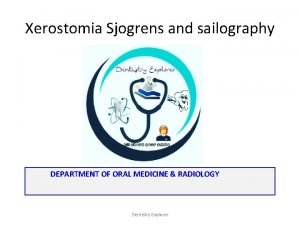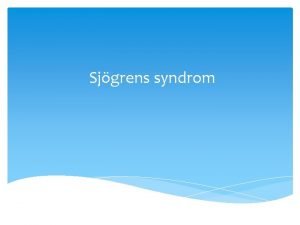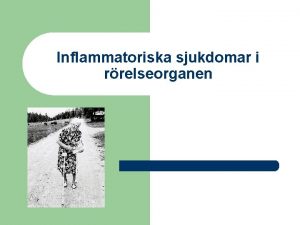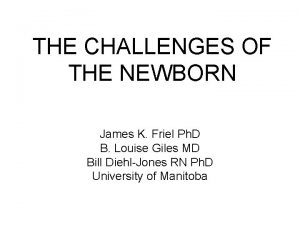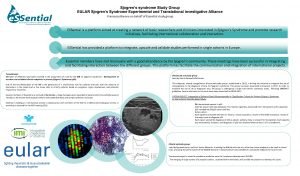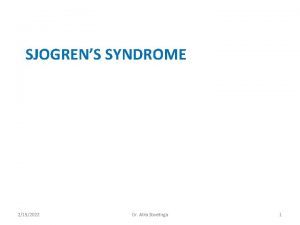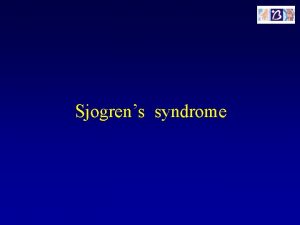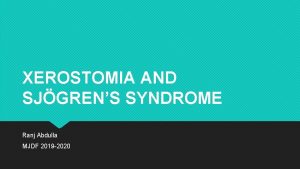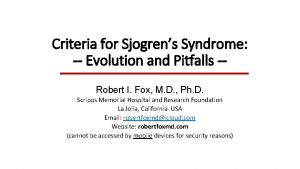Sjogrens Syndrome and Xerostomia An Overview Paul Friel













- Slides: 13

Sjogren’s Syndrome and Xerostomia – An Overview Paul Friel August 2016

Definition of Xerostomia • dry mouth • <0. 2 ml per minute whole saliva flow

Sjogren’s Syndrome Primary – xerostomia (dry mouth) and keratoconjunctivitis (dry eyes) Secondary – as above, plus a connective tissue disorder, most commonly rheumatoid arthritis, SLE, or mixed connective tissue disorder It is a chronic, multisystem autoimmune disorder, affecting the lacrimal and salivary glands. It most commonly affects middleaged women.

Causes of Xerostomia 1. Drugs • • antidepressants (tricyclics, MAOIs and SSRIs) antihistamines antihypertensives (ACE inhibitors, B-blockers) diuretics PPIs (anti-reflux) antimuscarinics benzodiazepines opioid analgesics

Causes of Xerostomia 2. Dehydration • • • diabetes renal failure age 3. 4. 5. 6. 7. Sjogren’s Syndrome Irradiation of the head and neck Neurological (rare) Developmental (rare) Smoking

Incidence of Xerostomia • 13% of UK population

Xerostomia can be classified as: subjective (false) – feels dry to patient but normal salivary flow e. g. mouth-breathing or objective (true) – reduced salivary flow

Related Dental/Oral Problems 1. Caries – especially cervical/incisal caries 2. Periodontal disease 3. Infections – especially fungal infections 4. Difficulty with dentures 5. Oral discomfort 6. Taste disturbances

Assessment 1. History and medical history – especially regarding drug therapy 2. Examination • • • ‘sticking’ of mirror to mucosa ‘frothy’ saliva/lack of pooling lobulated, fissured dorsum debris interdentally ‘glazed’ gingivae denture stomatitis

Sjogren’s Syndrome Investigations 1. Unstimulated whole saliva flow rate (10 minutes) < 0. 2 ml per minute indicates xerostomia 2. Stimulated parotid flow 3. Lacrimal flow (Schirmer test) 4. Parotid sialogram – shows ‘punctate sialectasis’ (snowstorm appearance) 5. Labial gland biopsy – shows focal lymphocytic sialadenitis

Management of Xerostomia 1. Regular sips of water (not drinking it) 2. Maintain fluid intake 3. Avoid xerostomia-inducing drugs 4. Artificial saliva • • • spray (Saliva Orthana) gel (Biotene) mouthwash

Management of Xerostomia 5. Use of sugar-free chewing gum/mints 6. Pilocarpine if severe (can cause sweating, GIT problems, and facial flushing) 5. Dietary advice • • non-cariogenic diet avoid use of acidic foods (e. g. citrus fruits) to stimulate saliva 8. Fluoride

Management of Xerostomia 8. Fluoride • • • high-fluoride toothpaste (Duraphat 2800 ppm) daily fluoride mouthwash regular application of 5% Na. F varnish by dental professional 9. Chlorhexidine mouthwash 10. Regular dental examinations and hygiene visits
